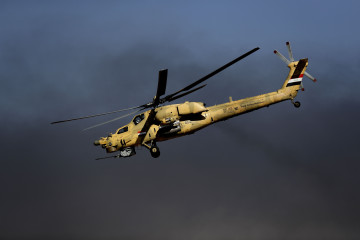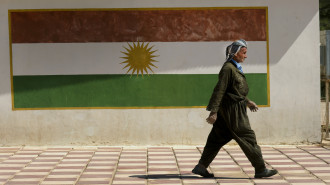

“Iraq needs a sophisticated air defence system,” Bader Al-Ziyadi, a member of the Iraqi parliament’s security and defence committee, said in October.
Al-Ziyadi noted that the current year’s budget would not fund such an expensive purchase but underlined that the country needs to improve its air defences.
He isn’t wrong. After all, Iraq hasn’t had any formidable air defences for over 30 years now.
In the post-2003 period, the only notable air defences Iraq purchased were some medium-range Russian Pantsir-S1 systems in the 2010s. However, these are designed for point air defence of limited areas, military bases, or other critical installations rather than more general area defence.
Iraq has reportedly considered buying more sophisticated longer-range high-altitude S-300 or S-400 air defence systems from Russia numerous times in recent years. Possession of a few of those advanced systems could cover large parts of Iraq’s airspace and pose a significant challenge to any intruder trying to violate it.
"In the post-2003 era, it was speculated that the Iraqi military would buy predominantly American hardware and model itself after the US military"
Iraq also has a long track record of buying Soviet, and later Russian, military hardware. Iraq procured the majority of its surface-to-air missile systems throughout the long rule of Saddam Hussein from the former Soviet Union along with most of its warplanes, including fourth-generation MiG-29A Fulcrum jets.
In the post-2003 era, it was speculated that the Iraqi military would buy predominantly American hardware and model itself after the US military. And indeed, it did receive a large fleet of American M1A1 Abrams main battle tanks and, beginning in 2015, F-16 fighter-bombers. Nevertheless, Iraq has shown it still has a preference for Russian hardware in recent years.
Baghdad, for example, bought Russian Mi-28 and Mi-35 attack helicopters instead of US AH-64 Apaches. Late in the 2010s, it also bought Russian T-90 main battle tanks instead of opting for more M1A1s. Therefore, it wouldn’t be at all that surprising if it sought Russian air defences in addition to armour and helicopters.
However, Iraq could be discouraged from doing so by the prospect of incurring sanctions under the US Countering America’s Adversaries Through Sanctions Act (CAATSA) law passed in 2017. That law obligates the United States Government to impose sanctions on any country that makes significant transactions with the Russian defence sector.
Procurement of advanced and expensive systems such as the S-300 and S-400 would undoubtedly qualify for CAATSA sanctions. For example, Turkey’s purchase of S-400s resulted in CAATSA sanctions being imposed on Ankara last year.
Baghdad would not face sanctions, on the other hand, if it decided to buy advanced air defence missile systems from France or South Korea.
Iraq has also made sizable procurements from Paris (historically) and Seoul (in recent years).
France was also a major supplier of arms to Iraq in the 1970s and 1980s. Paris sold Iraq a large fleet of Dassault Mirage F-1 multirole fighter jets. It even loaned the Iraqi Air Force five Super Étendard bombers from its own navy as Baghdad awaited delivery of Mirage jets.
|
|
Iraq promptly put those borrowed French warplanes to work attacking commercial shipping in the Persian Gulf during the ferocious Iran-Iraq War, which raged throughout that decade.
Paris also designed a sophisticated command-and-control (C2) system called KARI (Iraq in French spelt backwards) for Iraq’s multi-layered air defence system. KARI was designed to enable Baghdad to effectively coordinate its various air defences from its high-altitude surface-to-air missiles and interceptor aircraft to its low-altitude antiaircraft artillery (AAA) and shoulder-launched missiles.
The US-led coalition destroyed the system during the 1991 Persian Gulf War.
Today, it’s unclear what air defences Iraq might seek from France. It might eventually request to buy the Aster 30 SAMP/T (Surface-to-Air Missile Platform/Terrain), a long-range missile capable of shooting down aircraft, cruise missiles, and tactical ballistic missiles.
A few of these systems could hugely improve Iraq’s ability to monitor and protect vast swathes of its airspace without the risk of incurring US sanctions.
"It would hardly be surprising if Baghdad's future air defences came from either Moscow, Paris, or Seoul"
Then there is South Korea. In the 2010s, Baghdad took delivery of two dozen KAI T-50 Golden Eagle supersonic jet trainers from Seoul. The aircraft was South Korea’s first indigenously built supersonic aircraft and can be used as a light combat aircraft. The T-50 variant built for Iraq was designated the T-50IQ.
South Korea welcomes future arms deals with Iraq. In April, South Korean President Moon Jae-in indicated that Iraq might potentially become a buyer of the KF-21 Boramae, an advanced 4.5-generation fighter that Seoul is presently developing.
In the meantime, South Korea could offer Iraq the medium-range KM-SAM system, also known as the Cheongung.
The relatively new system hasn’t yet been exported. As recently as November, however, the United Arab Emirates (UAE) has expressed its interest in procuring it in a deal that could be worth up to $3.5 billion. The UAE Ministry of Defence said the KM-SAM would make a “qualitative addition” to Abu Dhabi’s formidable multi-layered air defences.
The KM-SAM could also prove a logical choice for Iraq’s air defence requirements.
The system was developed with technical assistance from Russia and is based on technology from the 9M96 missile used by the S-400 and S-350E systems. However, as Global Security noted: “Localization and industrialization was carried out in South Korea enough to be considered a local system.”
Therefore, KM-SAM could provide Iraq with an alternative to the S-400 without antagonising the United States or risking sanctions. Buying the KM-SAM could also help strengthen its defence ties with South Korea.
Given all these factors, it would hardly be surprising if Baghdad’s future air defences came from either Moscow, Paris, or Seoul.
Paul Iddon is a freelance journalist based in Erbil, Iraqi Kurdistan, who writes about Middle East affairs.
Follow him on Twitter: @pauliddon




 Follow the Middle East's top stories in English at The New Arab on Google News
Follow the Middle East's top stories in English at The New Arab on Google News


